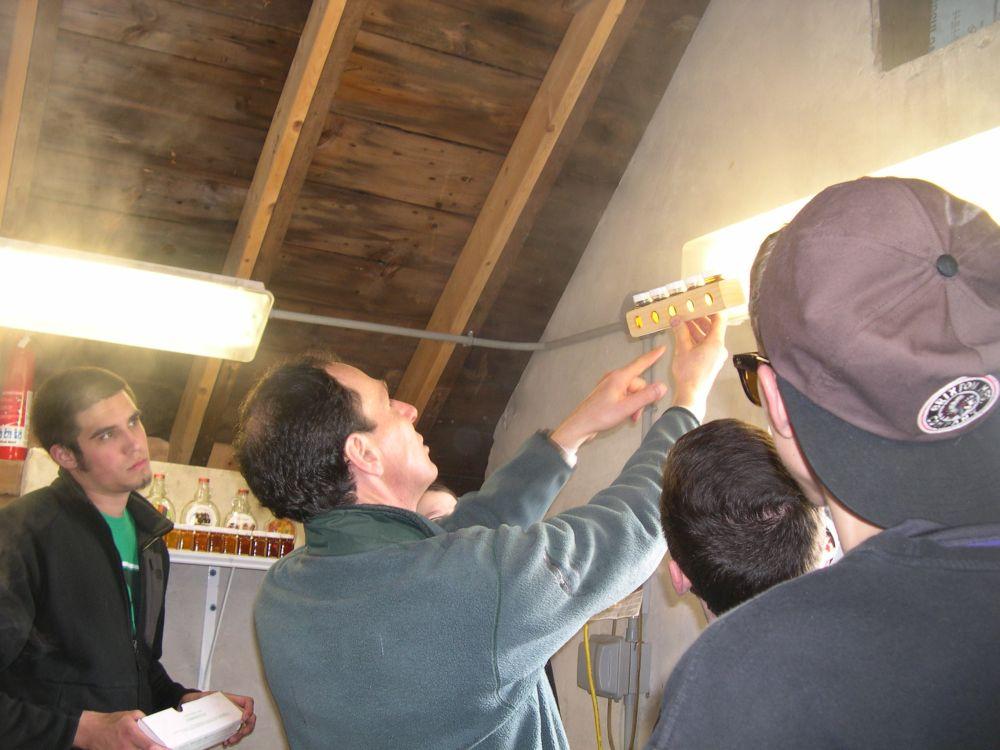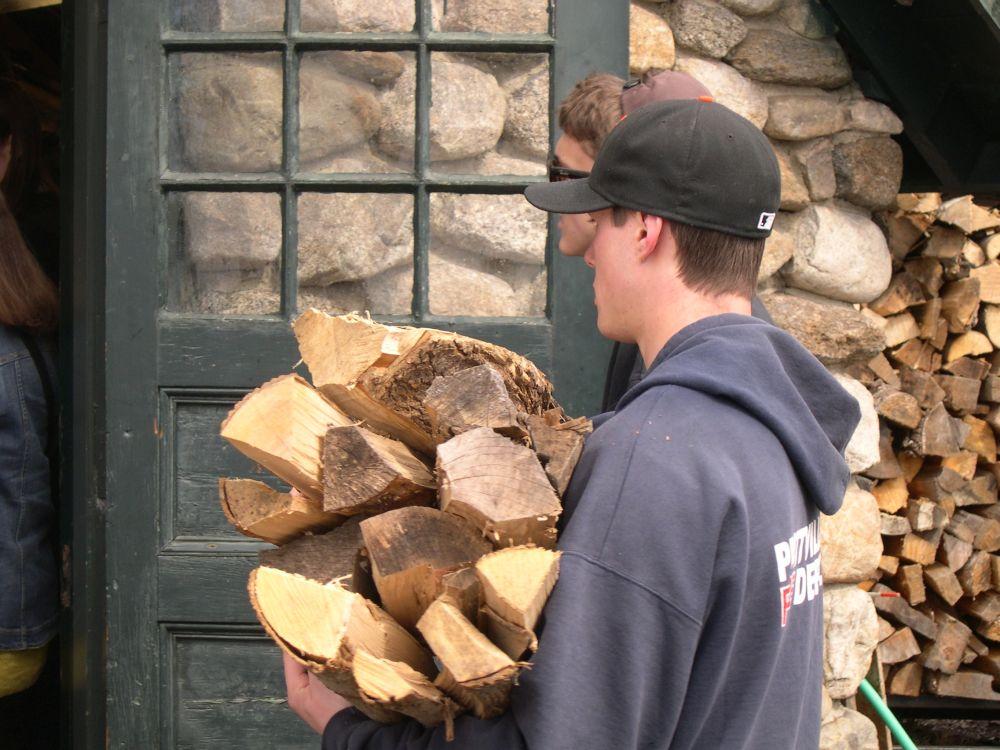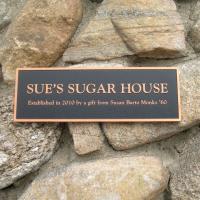- Tags:
- Working Forests

Colby-Sawyer College Professor Nick Baer shows the maple syrup color grading kit to students inside the college sugarhouse. Photo Dave Anderson
On the first warm April afternoon, Colby-Sawyer College students gathered maple sap from buckets and fed wood into the fire roaring beneath boiling sap pans in the college’s maple sugarhouse.

Maple season got off to a late start statewide. But recent sunshine and warm temperatures had buckets filled to their rims two days in a row. Students who’d been gathering sap across campus arrived at the sugarhouse, walking alongside a battered gray pick-up truck loaded with two full 50-gallon plastic barrels. They rigged an electric pump and garden hose to pump clear sap to a bulk tank while others carried wood or monitored the boiling sap.
This is the fifth maple season professors, Nick Baer and Leon Malan are integrating maple sugaring into science classes to provide practical applications of physical science, biology and ecology.
Enveloped in maple steam, Baer deftly weaves amid students while preparing to draw-off the first syrup this year. He settles foam on the roiling sap pan with vegetable oil while explaining the process as the syrup point on the thermometer is finally reached. “More wood!” is the cry every six minutes to students stoking the fire. Other students carry split pine logs from outside to replenish the sugarhouse supply.
One student turns to me and instructs: “See? Sap comes in here at two to three percent sugar and it’s boiled down to 67 percent when drawn-off for bottling.” I nod and smile at his simplified explanation. Students know their maple math.
Each maple on the sugaring circuit wears a numbered plastic tag. Some maples have names. “Sweet Mary” is famed for consistently yielding sap with up to six percent sugar content. Most other campus trees run three to four percent at best. Students gather data at each of 125 taps recording sap volume and use a sap hydrometer to measure liquid density to reveal sugar content. Sugar content tails-off during the brief season and this spring, weather swung from too cold by day in March to too warm at night in April for reliable sap runs.
Open-grown campus maples exhibit large spreading crowns. Unlike crowded forest-grown trees, these pasture (or front lawn) “sap cows” face no competition with neighbors for sunlight. At one time, the college tapped sugar maples in nearby woods, collecting sap with plastic tubing rather than buckets. In dense woods, the sugar content averaged only one to two percent - almost not worth the wood and time to boil it.
Total college syrup production has varied annually from 29 gallons in 2010 to 40 gallons last year. The record year was 2011 when classes produced 55 gallons during an extended season of perfect weather when many other NH sugar-makers ran out of fuel wood before sap. Conversely, in March, 2012, temperatures soared to 80 degrees and total syrup production plummeted to 16 gallons. This year, they made the first two gallons April 2, one day after sweetening the pans - their latest start ever.
Professors Baer and Malan had used invasive Norway maple firewood culled from the college woods in the evaporator. A foreign student incorrectly assumed maple sap was somehow cooked from burning wood in the fire and condensed as steam back into the syrup pan. Few of the 20 students in the sugaring lab had any prior experience maple sugaring. Most hail from urban and suburban backgrounds. Yet students readily rattle-off maple facts and what they’ve deduced thus far:

Kyler: “It takes much longer; I didn’t realize sap tastes like water”
Brett: “It’s relaxing, more chilled-out - same vibe as hiking with no cell phone.”
Peter: “Cool process; takes a long time. First time I’ve seen and tasted the end result – the final product.”
Zach: “Actually, we keep very careful records that go back five years to 2010. We did a lab experiment to compare the past several years’ data for specific tree’s sap output by volume and sugar content. We concluded that variability from year to year has more to do with weather than any other factor.”
Just back from a sap-gathering run, Matt offers: “Seems like older and larger trees tend to give more sap regardless of weather. We’re learning about variability. Some trees that yield less sap volume have higher sugar. That’s what I gathered.”
Yes, literally gathered – both sap and data.
Sugaring lessons extend to a wider community. Baer explains how other academic departments are involved. Graphic design students create custom labels for eight-ounce, clear glass syrup bottles. Creative writing students write poems for the labels. Business students conducted a break-even analysis – not pretty. Art students made ceramics for a special pancake dinner served at the Sodexo-operated college dining hall.
Says Baer: “We’re teaching a true integrated course across the curriculum. We work to find ways to intentionally involve the entire campus and touch the larger community wherever possible.”
Alumnus Susan Monks, CSC Class of ’60, provided funds to renovate the quaint stone building and install new equipment. The President’s Office and Alumni office provide gift bottles of college syrup to speakers and dignitaries at Commencement. Surplus syrup – if any - is packaged and sold locally. Supplies are generally limited and will be particularly so this year.
Back inside the sugarhouse, an Admissions Office tour stops-by. “Smells good” offers one smiling visitor. Everyone is smiling… and why not? It’s been a long winter but now maple steam rolls from roof vents and dark pine smoke spews from the chimney. A steady stream of questions gushes from visitors. Baer and the students cheerfully drizzle condensed answers.
Dr. Leon Malan poses more difficult questions: “Why are some trees sweeter than others? How does increasing density in the sap pan push sap ahead of it in the boiling process? He offers “It makes a good lab. We could teach about maple in class using books and diagrams, but what better way to learn than by engaging students in the process?”

Students disperse after class. Dr. Baer sings after them “Thanks for recording data!” He turns to the lingering knot of students and suggests “More wood?”
Baer teaches a “Science of Maple Sugaring” course for 12 students. Intern Sarah Fischer took the class last year and says “the coolest thing is how the weather has to be just right. It’s an amazing process to experience and learn.”
Student independent projects from the course ranged from a maple cookbook with heirloom family recipes to a study of effects of check valves in maple tubing. Others conducted a regional survey of maple producers to assess annual sugar production, sap yields per tap, and how technologies including vacuum and reverse osmosis enhance production.
Environmental Studies Chair Dr. Laura Alexander gestures at the sugarhouse. “This reminds everybody on campus where syrup comes from. When smoke is rolling from the stack and steam is coming from the vents, people just stop by – the entire campus community becomes more aware of where we live.”
To which I might add: and why we live here too.
